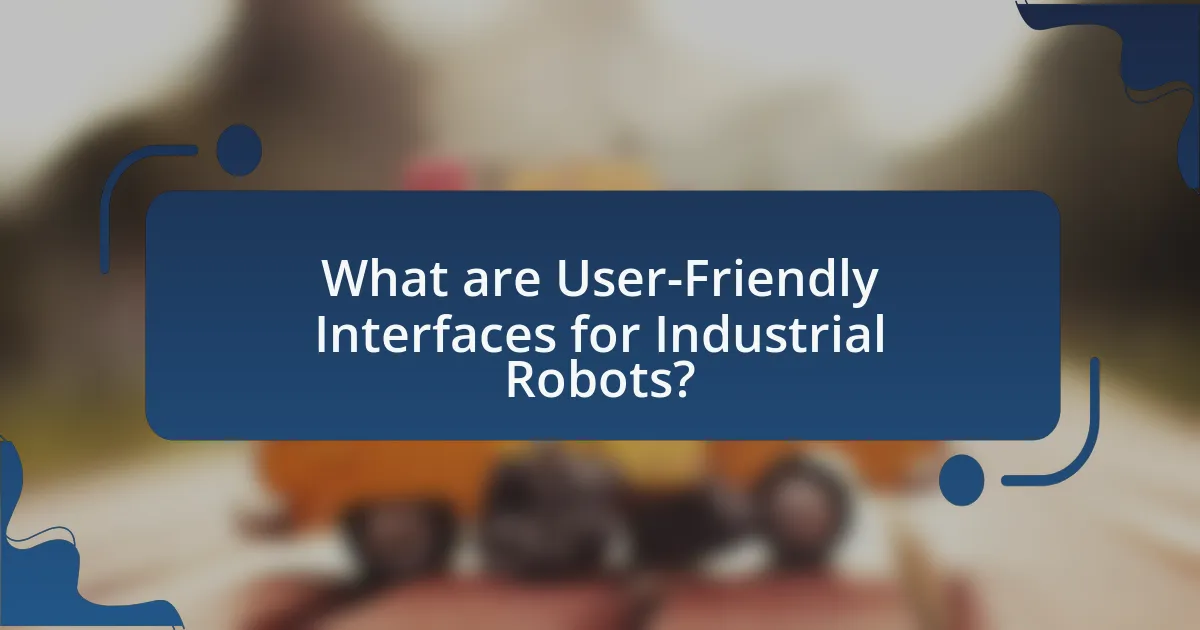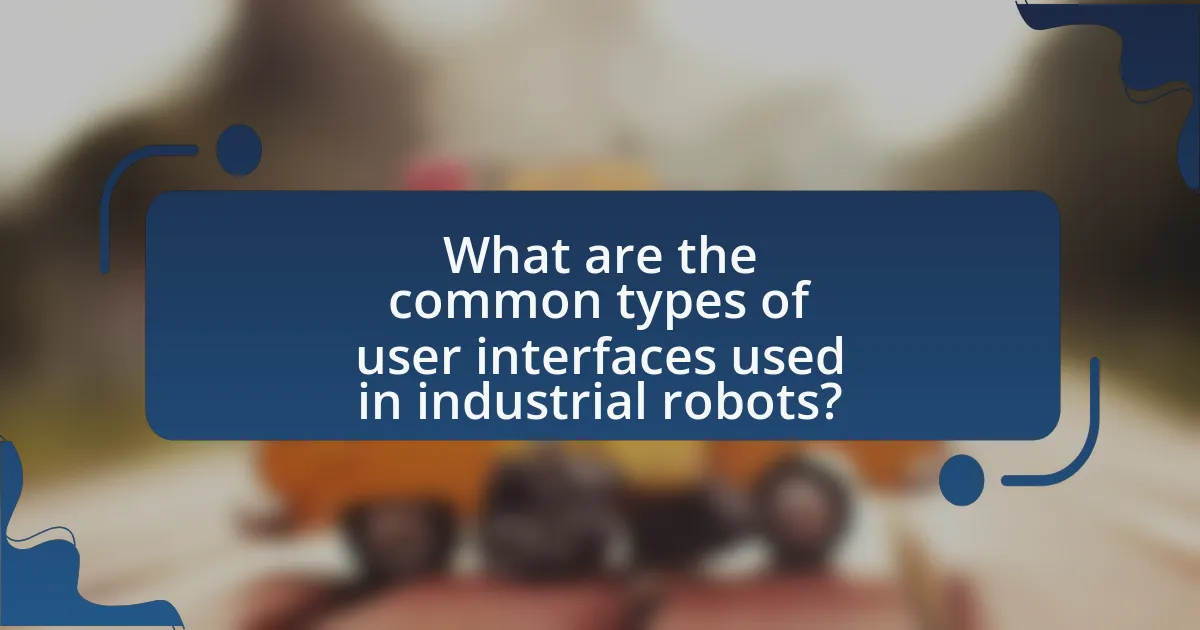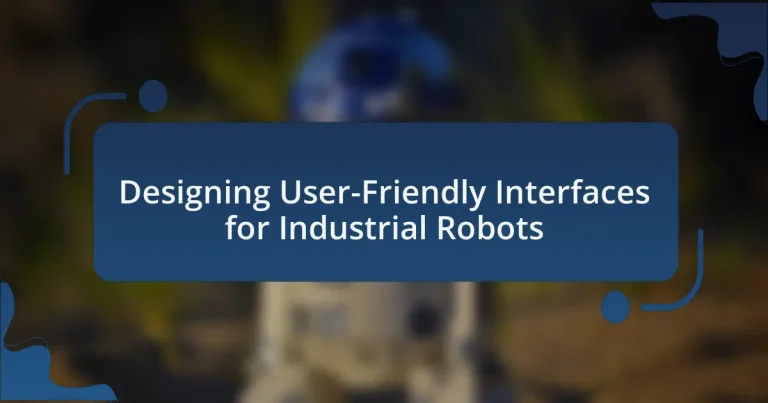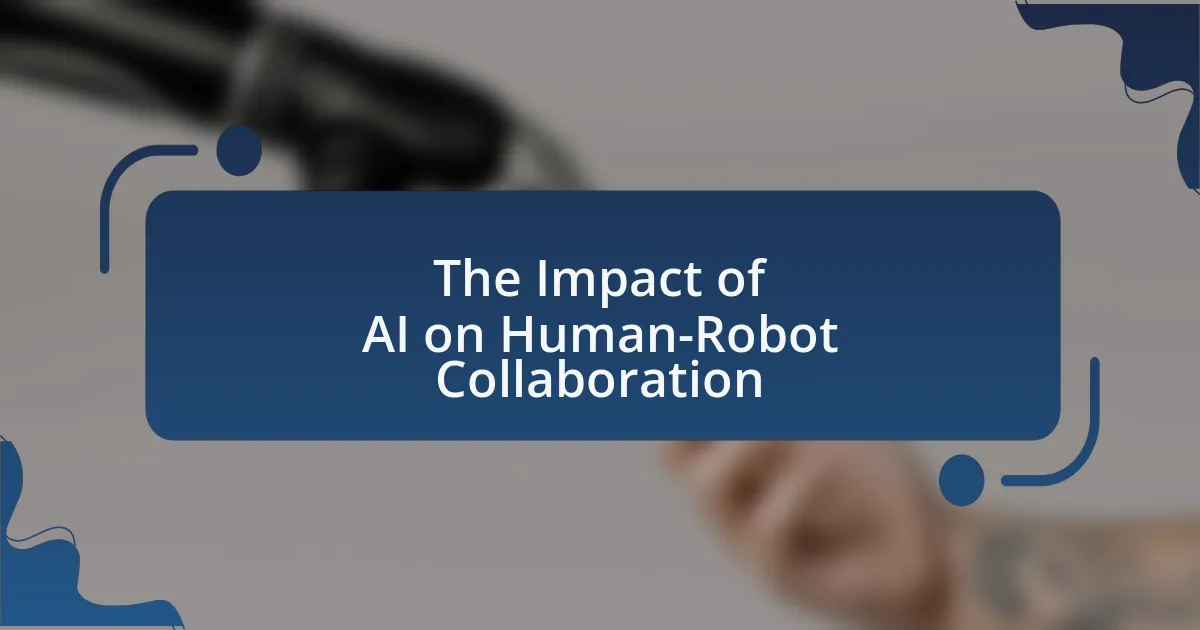User-friendly interfaces for industrial robots are essential systems that enable operators to interact easily with robotic systems through intuitive designs such as graphical user interfaces (GUIs) and touchscreens. These interfaces enhance operational efficiency by simplifying programming, monitoring, and control, leading to reduced training time and operational errors. Key features include intuitive navigation, clear visual feedback, and customizable settings, all of which contribute to improved user experience and productivity. The article explores the critical role of interface design in industrial robotics, the challenges faced without user-friendly systems, and best practices for creating effective interfaces that meet diverse user needs.

What are User-Friendly Interfaces for Industrial Robots?
User-friendly interfaces for industrial robots are systems designed to facilitate easy interaction between operators and robotic systems. These interfaces often include graphical user interfaces (GUIs), touchscreens, and intuitive control panels that allow users to program, monitor, and control robots with minimal training. For instance, the integration of visual programming tools, such as drag-and-drop functionalities, enhances usability by enabling operators to create complex tasks without extensive coding knowledge. Studies have shown that user-friendly interfaces can significantly reduce operational errors and improve productivity, as evidenced by a report from the International Federation of Robotics, which highlights that companies adopting intuitive interfaces experience a 30% increase in efficiency.
How do user-friendly interfaces enhance the operation of industrial robots?
User-friendly interfaces enhance the operation of industrial robots by simplifying interaction and improving accessibility for operators. These interfaces allow users to easily program, monitor, and control robotic systems, reducing the learning curve and minimizing errors. For instance, intuitive graphical user interfaces (GUIs) enable operators to visualize robot tasks and workflows, which can lead to increased efficiency and productivity. Research indicates that companies implementing user-friendly interfaces report up to a 30% reduction in training time for new employees, demonstrating the tangible benefits of such designs in industrial settings.
What key features define a user-friendly interface in this context?
A user-friendly interface for industrial robots is defined by intuitive navigation, clear visual feedback, and customizable settings. Intuitive navigation allows users to easily understand and operate the system without extensive training, which is crucial in industrial environments where efficiency is key. Clear visual feedback, such as status indicators and error messages, ensures that users can quickly assess the robot’s performance and respond to issues, enhancing operational safety. Customizable settings enable users to tailor the interface to their specific needs, improving usability and satisfaction. These features collectively contribute to a more efficient and effective interaction between operators and industrial robots.
How do these features improve user experience and efficiency?
User-friendly features in industrial robot interfaces enhance user experience and efficiency by simplifying interactions and reducing operational errors. Intuitive designs, such as visual aids and touchscreens, allow users to navigate systems easily, leading to quicker task completion. For instance, studies show that interfaces with clear visual feedback can decrease training time by up to 30%, enabling operators to become proficient faster. Additionally, customizable settings cater to individual user preferences, further streamlining workflows and increasing productivity.
Why is the design of user interfaces critical in industrial robotics?
The design of user interfaces is critical in industrial robotics because it directly impacts operator efficiency, safety, and overall system performance. Effective user interfaces facilitate intuitive interaction between humans and robots, reducing the likelihood of errors and enhancing productivity. Research indicates that well-designed interfaces can decrease training time by up to 50%, allowing operators to quickly adapt to complex robotic systems. Furthermore, user-friendly designs improve situational awareness, enabling operators to monitor and control robotic processes more effectively, which is essential in high-stakes environments such as manufacturing and assembly lines.
What challenges do operators face without user-friendly interfaces?
Operators face significant challenges without user-friendly interfaces, including increased error rates and reduced efficiency. Complex interfaces can lead to misunderstandings of system commands, resulting in operational mistakes that can compromise safety and productivity. For instance, a study by the International Journal of Human-Computer Interaction found that poorly designed interfaces can increase task completion time by up to 30%, highlighting the impact on operational efficiency. Additionally, operators may experience higher cognitive load, leading to fatigue and decreased job satisfaction, which further exacerbates performance issues.
How can effective design mitigate these challenges?
Effective design can mitigate challenges in designing user-friendly interfaces for industrial robots by enhancing usability and reducing complexity. By employing intuitive layouts, clear visual hierarchies, and consistent interaction patterns, designers can facilitate easier navigation and operation for users. Research indicates that user-centered design principles, such as usability testing and iterative design, lead to interfaces that significantly decrease error rates and improve user satisfaction. For instance, a study by Nielsen Norman Group found that well-designed interfaces can reduce task completion time by up to 50%, demonstrating the tangible benefits of effective design in overcoming usability challenges.
What principles guide the design of user-friendly interfaces for industrial robots?
User-friendly interfaces for industrial robots are guided by principles such as simplicity, consistency, feedback, and accessibility. Simplicity ensures that the interface is easy to understand and navigate, reducing the cognitive load on users. Consistency across the interface allows users to predict outcomes based on their previous interactions, enhancing usability. Feedback provides users with immediate responses to their actions, confirming that commands have been received or executed, which is crucial for operational safety. Accessibility ensures that the interface can be used by individuals with varying levels of expertise and physical abilities, promoting inclusivity. These principles are supported by usability studies that demonstrate improved efficiency and reduced error rates when these guidelines are followed in interface design.
What role does usability play in interface design?
Usability is crucial in interface design as it directly impacts user satisfaction and efficiency. A well-designed interface enhances the ease with which users can interact with a system, leading to reduced errors and increased productivity. For instance, studies show that improving usability can lead to a 50% increase in task completion rates, demonstrating its significance in creating effective user experiences. In the context of industrial robots, high usability ensures that operators can quickly learn and effectively use the interface, minimizing downtime and enhancing operational safety.
How can designers ensure accessibility for all users?
Designers can ensure accessibility for all users by implementing inclusive design principles that accommodate diverse needs. This involves using clear visual elements, providing alternative text for images, ensuring keyboard navigability, and adhering to established accessibility standards such as the Web Content Accessibility Guidelines (WCAG). Research indicates that approximately 15% of the global population experiences some form of disability, highlighting the necessity for accessible design to enhance usability for everyone.
How can user feedback influence interface design?
User feedback can significantly influence interface design by providing insights into user needs and preferences, which can lead to more intuitive and effective interfaces. For instance, when users report difficulties in navigating an interface, designers can identify specific pain points and make targeted adjustments, such as simplifying navigation or enhancing visual elements. Research conducted by Nielsen Norman Group indicates that usability testing, which incorporates user feedback, can improve user satisfaction by up to 80%. This demonstrates that integrating user feedback not only enhances the design process but also results in interfaces that better meet user expectations and improve overall usability.
What methods are effective for gathering user feedback?
Effective methods for gathering user feedback include surveys, interviews, usability testing, and focus groups. Surveys allow for quantitative data collection from a large audience, while interviews provide qualitative insights through direct interaction. Usability testing involves observing users as they interact with the interface, revealing pain points and areas for improvement. Focus groups facilitate discussions among users, generating diverse perspectives on the interface design. Research indicates that combining these methods enhances the richness of feedback, leading to more informed design decisions. For instance, a study published in the Journal of Usability Studies found that usability testing combined with surveys resulted in a 30% increase in identifying user issues compared to using either method alone.

What are the common types of user interfaces used in industrial robots?
The common types of user interfaces used in industrial robots include teach pendants, graphical user interfaces (GUIs), and web-based interfaces. Teach pendants are handheld devices that allow operators to manually control and program robots, providing a direct and intuitive way to interact with the robot. GUIs offer visual representations of robot operations, enabling users to monitor and control tasks through screens with icons and menus, which enhances usability. Web-based interfaces allow remote access and control of robots via internet browsers, facilitating easier management and integration with other systems. These interfaces are designed to improve user interaction and operational efficiency in industrial settings.
What are the differences between graphical and textual interfaces?
Graphical interfaces use visual elements like icons and windows, while textual interfaces rely on text-based commands and outputs. Graphical interfaces enhance user experience by providing intuitive navigation and immediate feedback through visual cues, making them more accessible for users with varying levels of technical expertise. In contrast, textual interfaces often require users to memorize commands and syntax, which can lead to a steeper learning curve. Studies show that graphical interfaces can reduce task completion time by up to 50% compared to textual interfaces, highlighting their efficiency in user interaction.
How do graphical interfaces improve user interaction?
Graphical interfaces improve user interaction by providing intuitive visual representations of complex data and functions, which enhances user comprehension and engagement. These interfaces utilize elements such as icons, buttons, and visual feedback to simplify navigation and task execution, making it easier for users to interact with systems, especially in industrial settings. Research indicates that users can complete tasks up to 50% faster when using graphical interfaces compared to text-based interfaces, as visual cues reduce cognitive load and facilitate quicker decision-making.
What are the limitations of textual interfaces?
Textual interfaces have several limitations, primarily related to usability and accessibility. Users often struggle with understanding complex commands and syntax, which can lead to errors and frustration. Additionally, textual interfaces lack visual feedback, making it difficult for users to gauge the system’s status or progress. Research indicates that 70% of users prefer graphical interfaces for their intuitiveness, highlighting the challenge of engaging users with purely textual systems. Furthermore, textual interfaces can be less accessible for individuals with disabilities, as they may not support screen readers or other assistive technologies effectively. These factors collectively hinder the efficiency and effectiveness of user interactions with industrial robots.
How do touchscreens compare to traditional control panels?
Touchscreens offer greater flexibility and interactivity compared to traditional control panels. Unlike traditional panels, which rely on physical buttons and switches, touchscreens allow for dynamic interfaces that can be customized for various tasks and user preferences. This adaptability enhances user experience by providing visual feedback and the ability to display complex information in an intuitive manner. Studies indicate that touchscreens can reduce training time for operators by up to 30% due to their user-friendly design and ease of navigation, making them particularly effective in industrial settings where efficiency is crucial.
What advantages do touchscreens offer in industrial settings?
Touchscreens offer several advantages in industrial settings, including enhanced user interaction, increased efficiency, and improved accessibility. The intuitive nature of touchscreens allows operators to quickly navigate complex systems, reducing training time and minimizing errors. For instance, a study by the International Journal of Advanced Manufacturing Technology found that touchscreens can decrease task completion time by up to 30% compared to traditional interfaces. Additionally, touchscreens can be customized for specific applications, allowing for tailored controls that meet the unique needs of various industrial processes. This adaptability further supports operational efficiency and user satisfaction in demanding environments.
What considerations must be made for touchscreen usability?
Touchscreen usability requires considerations such as screen size, touch sensitivity, user interface design, and feedback mechanisms. A larger screen size facilitates easier interaction, while appropriate touch sensitivity ensures that users can accurately select options without frustration. User interface design must prioritize clarity and simplicity, utilizing large buttons and intuitive layouts to enhance accessibility. Feedback mechanisms, such as visual or haptic responses, confirm user actions and improve the overall experience. Research indicates that effective touchscreen design can significantly reduce user error rates and increase task efficiency, as demonstrated in studies on human-computer interaction.
What emerging technologies are influencing interface design?
Emerging technologies influencing interface design include artificial intelligence, augmented reality, and voice recognition. Artificial intelligence enhances user interfaces by enabling adaptive learning and personalized experiences, allowing systems to anticipate user needs and streamline interactions. Augmented reality provides immersive visualizations that improve user understanding of complex data and tasks, particularly in industrial settings. Voice recognition technology facilitates hands-free operation, making interfaces more accessible and efficient for users engaged in manual tasks. These technologies collectively enhance usability and functionality in interface design, particularly for industrial robots, by improving interaction efficiency and user satisfaction.
How is augmented reality being integrated into industrial robot interfaces?
Augmented reality (AR) is being integrated into industrial robot interfaces by overlaying digital information onto the physical environment, enhancing operator interaction and efficiency. This integration allows workers to visualize robot operations, receive real-time data, and access interactive instructions directly in their line of sight. For instance, companies like Siemens and Boeing have implemented AR systems that enable technicians to see assembly instructions and maintenance alerts projected onto the machinery, significantly reducing error rates and training time. Studies indicate that AR can improve task performance by up to 30%, demonstrating its effectiveness in streamlining industrial processes.
What potential does voice control have in enhancing user interaction?
Voice control has significant potential in enhancing user interaction by providing a hands-free, intuitive method for users to communicate with industrial robots. This technology allows operators to issue commands and receive feedback without the need for physical interfaces, which can improve efficiency and reduce the risk of errors. For instance, a study by the Massachusetts Institute of Technology found that voice-activated systems can increase task completion speed by up to 30% in industrial settings, demonstrating the effectiveness of voice control in streamlining operations. Additionally, voice control can enhance accessibility for users with disabilities, making it easier for a broader range of individuals to interact with complex machinery.

What are best practices for designing user-friendly interfaces for industrial robots?
Best practices for designing user-friendly interfaces for industrial robots include prioritizing intuitive design, ensuring clear feedback mechanisms, and facilitating easy navigation. Intuitive design allows operators to understand and use the interface without extensive training, which is crucial in fast-paced industrial environments. Clear feedback mechanisms, such as visual and auditory signals, inform users about the robot’s status and actions, enhancing situational awareness. Easy navigation through logical layouts and accessible controls minimizes user errors and increases efficiency. Research by the Human Factors and Ergonomics Society highlights that user-centered design significantly improves operational safety and productivity in industrial settings.
How can designers prioritize user needs in the design process?
Designers can prioritize user needs in the design process by conducting thorough user research and usability testing. This approach ensures that the design is informed by actual user experiences and preferences, allowing designers to identify key pain points and requirements. For instance, studies have shown that involving users early in the design phase can lead to a 50% reduction in redesign costs, as highlighted in the research by Nielsen Norman Group. By continuously iterating based on user feedback, designers can create interfaces that are not only functional but also intuitive and aligned with user expectations.
What techniques can be used to identify user requirements?
Techniques to identify user requirements include interviews, surveys, focus groups, and usability testing. Interviews allow for in-depth understanding of user needs through direct conversation, while surveys can gather quantitative data from a larger audience. Focus groups facilitate discussion among users to uncover diverse perspectives and insights. Usability testing evaluates how real users interact with a prototype, revealing practical requirements based on their experiences. These methods are widely recognized in user-centered design practices, ensuring that the final interface aligns with user expectations and enhances usability.
How can iterative design improve the final product?
Iterative design improves the final product by allowing continuous refinement based on user feedback and testing. This process enables designers to identify usability issues early and make necessary adjustments, leading to a more intuitive and effective interface. For instance, a study by the Nielsen Norman Group highlights that iterative testing can increase user satisfaction by up to 50% when user-centered design principles are applied. By incorporating real user insights at each stage, the final product becomes more aligned with user needs and expectations, ultimately enhancing its functionality and usability.
What role does testing play in the design of user interfaces?
Testing plays a critical role in the design of user interfaces by ensuring usability, functionality, and user satisfaction. Through various testing methods, such as usability testing and A/B testing, designers can identify issues and gather feedback from real users, which informs necessary adjustments to improve the interface. For instance, a study published in the Journal of Usability Studies found that usability testing can increase user satisfaction by up to 50% when iterative design changes are made based on user feedback. This evidence highlights that testing not only validates design choices but also enhances the overall user experience, making it essential in the development of user-friendly interfaces for industrial robots.
How can usability testing be effectively conducted?
Usability testing can be effectively conducted by following a structured approach that includes defining clear objectives, selecting representative users, and employing specific testing methods. First, establishing clear objectives ensures that the testing focuses on key usability aspects, such as task completion rates and user satisfaction. Next, selecting representative users who match the target demographic of the industrial robot interface allows for relevant feedback and insights. Finally, employing methods such as think-aloud protocols, where users verbalize their thoughts while interacting with the interface, provides valuable qualitative data. Research indicates that usability testing can improve user satisfaction by up to 50% when conducted systematically, as shown in studies by Nielsen Norman Group, which emphasize the importance of user-centered design in technology development.
What metrics should be used to evaluate interface effectiveness?
To evaluate interface effectiveness, key metrics include usability, user satisfaction, task completion rate, error rate, and time on task. Usability assesses how easily users can navigate and interact with the interface, often measured through standardized tests like the System Usability Scale (SUS). User satisfaction gauges the overall experience and can be quantified through surveys or Net Promoter Score (NPS). Task completion rate indicates the percentage of users who successfully complete a given task, reflecting the interface’s efficiency. Error rate tracks the frequency of user mistakes, providing insight into potential design flaws. Time on task measures how long it takes users to complete specific tasks, highlighting areas for improvement in interface design. These metrics collectively provide a comprehensive view of interface effectiveness in the context of user-friendly designs for industrial robots.
What are common pitfalls to avoid in interface design?
Common pitfalls to avoid in interface design include neglecting user needs, overcomplicating the interface, and failing to ensure consistency. Neglecting user needs can lead to designs that do not align with user expectations or workflows, resulting in frustration and inefficiency. Overcomplicating the interface with excessive features or clutter can overwhelm users, making it difficult for them to navigate and complete tasks effectively. Failing to ensure consistency across the interface can confuse users, as they may struggle to understand how different elements interact or behave. These pitfalls are supported by usability studies, which show that user-centered design significantly enhances user satisfaction and task performance.
How can overcomplicating interfaces hinder user experience?
Overcomplicating interfaces can significantly hinder user experience by creating confusion and increasing cognitive load for users. When interfaces are cluttered with excessive options, complex navigation, or unclear instructions, users may struggle to complete tasks efficiently. Research indicates that users can experience frustration and decreased productivity when faced with overly complicated systems, as evidenced by a study published in the International Journal of Human-Computer Interaction, which found that simplified interfaces led to a 30% increase in task completion rates. Therefore, a streamlined and intuitive design is essential for enhancing user satisfaction and operational efficiency in industrial robot interfaces.
What are the risks of neglecting user training and support?
Neglecting user training and support poses significant risks, including decreased operational efficiency and increased error rates. When users lack proper training, they may struggle to operate industrial robots effectively, leading to mistakes that can result in costly downtime or equipment damage. A study by the National Institute of Standards and Technology found that inadequate training can lead to a 30% increase in operational errors. Additionally, without ongoing support, users may become frustrated, which can lead to decreased morale and higher turnover rates. This lack of support can also hinder the adoption of new technologies, as users may resist changes they do not feel equipped to handle.
What practical tips can enhance the design of user-friendly interfaces for industrial robots?
To enhance the design of user-friendly interfaces for industrial robots, prioritize simplicity and clarity in the interface layout. A straightforward design minimizes cognitive load, allowing operators to quickly understand and interact with the system. Incorporating visual aids, such as icons and color coding, can further enhance comprehension and usability. Research indicates that interfaces with intuitive navigation reduce error rates by up to 30%, demonstrating the importance of user-centered design principles. Additionally, providing real-time feedback through visual or auditory signals helps users monitor robot performance effectively, fostering a more efficient operational environment.





